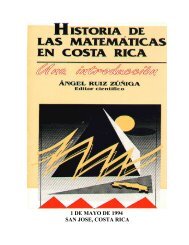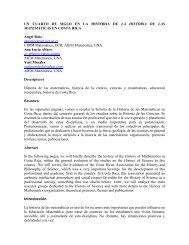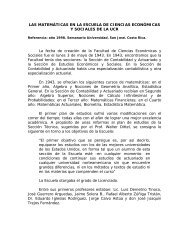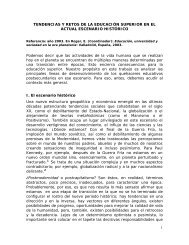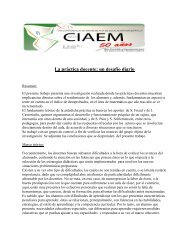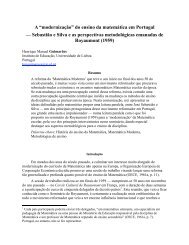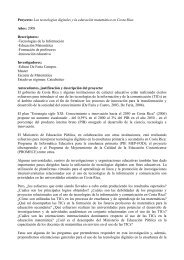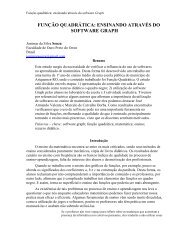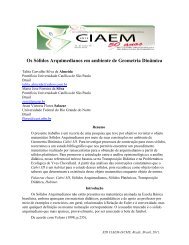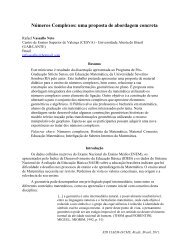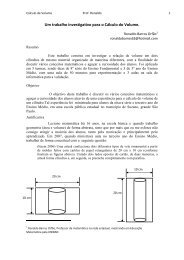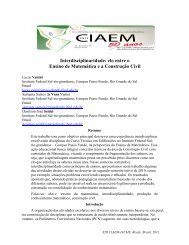Didactics of mathematics: more than mathematics and school! - CIMM
Didactics of mathematics: more than mathematics and school! - CIMM
Didactics of mathematics: more than mathematics and school! - CIMM
Create successful ePaper yourself
Turn your PDF publications into a flip-book with our unique Google optimized e-Paper software.
170 R. Straesser<br />
3 Utilitarian <strong>mathematics</strong> <strong>and</strong> ‘‘Bildung’’<br />
In Sect. 2, the consequences <strong>of</strong> looking into vocational<br />
<strong>mathematics</strong> education <strong>and</strong> some results <strong>of</strong> research<br />
into this type <strong>of</strong> teaching <strong>and</strong> learning <strong>and</strong> on research<br />
into <strong>mathematics</strong> at the workplace have been described.<br />
One could see how this field <strong>of</strong> research throws<br />
a new light onto the human struggle with <strong>mathematics</strong>,<br />
how this breaking out <strong>of</strong> the narrow confines <strong>of</strong> the<br />
institution classroom/<strong>school</strong> can add to didactics <strong>of</strong><br />
<strong>mathematics</strong>. Looking into <strong>mathematics</strong> in the workplace<br />
<strong>and</strong> in vocational education obviously has<br />
something to <strong>of</strong>fer to didactics <strong>of</strong> <strong>mathematics</strong> as a<br />
scientific discipline. One could also see that current<br />
research in this field is still mainly concerned with the<br />
subject matter <strong>mathematics</strong> <strong>and</strong> its role in the workplace<br />
<strong>and</strong> vocational education. The role <strong>and</strong> problems<br />
<strong>of</strong> the human learner are still somehow neglected in<br />
<strong>mathematics</strong> in vocational education.<br />
The typical German concept <strong>of</strong> ‘‘Bildung’’ may be<br />
an appropriate way to overcome this limitation. Even if<br />
the German word cannot be easily translated into<br />
English without loosing its distinct meaning, it may be<br />
a way to conceptually bridge the divide between the<br />
subject matter (to be) taught <strong>and</strong> the human being<br />
struggling with this subject matter. Steiner simply cited<br />
the well-known formula defining ‘‘Bildung’’ as what is<br />
left when everything that has been learned is forgotten<br />
(‘‘Wenn Bildung ... das ist, was übrig bleibt, wenn man<br />
vergessen hat, was man gelernt hat’’; Steiner 1972, p.<br />
334f). The afore-mentioned German educationalist<br />
Herwig Blankertz especially looked into Bildung from<br />
the perspective <strong>of</strong> vocational education (see Blankertz<br />
1969). In this paper, it is simply impossible to present<br />
the long-st<strong>and</strong>ing debate on ‘‘Bildung’’ <strong>and</strong> its implications<br />
for <strong>mathematics</strong> education in general. But it<br />
was the concept <strong>of</strong> ‘‘Bildung’’, which made Steiner<br />
aware <strong>of</strong> the fundamental role <strong>of</strong> the learner (see the<br />
citation in Sect. 1) <strong>and</strong> opened the way to his activities<br />
in vocational education, implying that Steiner inserted<br />
the question <strong>of</strong> ‘‘Bildung’’ into the vocational project<br />
he took part in. Mathematics education in <strong>and</strong> for the<br />
workplace can pr<strong>of</strong>it from taking into account the human<br />
side <strong>of</strong> the teaching/learning process—possibly<br />
with the help <strong>of</strong> the concept <strong>of</strong> ‘‘Bildung’’.<br />
There is also a lesson to be learnt for general<br />
<strong>mathematics</strong> education. Some ten years later in the<br />
1980s, the human part <strong>of</strong> didactics <strong>of</strong> <strong>mathematics</strong> is so<br />
evident, that Steiner makes ‘‘Bildung’’ a point <strong>of</strong> defence<br />
<strong>of</strong> the reform <strong>of</strong> the upper secondary <strong>mathematics</strong><br />
education bound for academic studies (the<br />
‘‘neugestaltete gymnasiale Oberstufe’’). According to<br />
Steiner, the pre-defined curriculum for everybody<br />
(with academic aspirations) should be substituted by an<br />
individually defined ‘‘diet’’ <strong>of</strong> learning objects <strong>and</strong><br />
experiences in order to have an adequate upper secondary<br />
education including <strong>mathematics</strong> (‘‘... die Beratungen<br />
und ... Betreuungen der Schüler ... unter dem<br />
Aspekt der Wahl eines individuellen Bildungsganges<br />
und damit unter bestimmte mit dem Bildungsgang<br />
verbundene Kompetenzentwicklungen zu stellen’’, see<br />
Steiner 1984, p. 21—explicitly referring to Blankertz<br />
<strong>and</strong> his reform work). Here again—<strong>and</strong> for general<br />
education, ‘‘Bildung’’ is the keyword to fight a utilitarian<br />
reduction <strong>of</strong> teaching <strong>and</strong> learning <strong>mathematics</strong><br />
in favour <strong>of</strong> a <strong>mathematics</strong> created for the individual<br />
learner.<br />
References<br />
Appelrath, K.-H. (1985). Zur Verwendung von Mathematik und<br />
zur Situation des Fachrechnens im Berufsfeld Metalltechnik<br />
(dargestellt an zwei Unterrichtsbeispielen). In P. Bardy, W.<br />
Blum, & H. G. Braun (Eds.), Mathematik in der Berufsschule<br />
- Analysen und Vorschläge zum Fachrechenunterricht.<br />
(pp. 127–139). Essen: Girardet.<br />
Bessot, A., & Ridgway, J. (2000). Education for <strong>mathematics</strong> in<br />
the workplace (Vol. 24). Dordrecht: Kluwer.<br />
Blankertz, H. (1969). Bildung im Zeitalter der grossen Industrie.<br />
Pädagogik, Schule und Berufsbildung im 19. Jahrhundert.<br />
Berlin: Hermann Schroedel.<br />
Blum, W., & Straesser, R. (1992). Mathematikunterricht in<br />
beruflichen Schulen zwischen Berufskunde und Allgemeinbildung.<br />
Zentralblatt für Didaktik der Mathematik 24(7),<br />
242–247.<br />
Brousseau, G. (1986). Forschungstendenzen der Mathematikdidaktik<br />
in Frankreich. Journal für Mathematikdidaktik 7(2/3),<br />
95–120.<br />
Brousseau, G. (1994). Perspectives pour la didactique des<br />
mathématiques. In M. Artigue (Eds.), Vingt Ans de Didactique<br />
des Mathématiques en France - Hommage à Guy<br />
Brousseau et Gerard Vergnaud (pp. 51–66). Grenoble: La<br />
Pensée Sauvage.<br />
Buchberger, B. (1989). Should students learn integration rules?<br />
(RISC-Linz-Series No. 89-07.0). Linz: RISC.<br />
Chevallard, Y. (1985/1991). La transposition didactique. Grenoble:<br />
Pensées sauvages.<br />
Griesel, H. (1971). Die Neue Mathematik für Lehrer und<br />
Studenten - B<strong>and</strong> 1: Mengen, Zahlen, Relationen, Topologie<br />
(Vol. 1). Hannover: Schroedel.<br />
Griesel, H. (1974). Überlegungen zur Didaktik der Mathematik<br />
als Wissenschaft. Zentralblatt für Didaktik der Mathematik<br />
6(3), 115–119.<br />
Heintz, B. (2000). Die Innenwelt der Mathematik. Zur Kultur<br />
und Praxis einer beweisenden Disziplin. Heidelberg: Springer.<br />
Howson, A. G., Kahane, J. P., Lauginie, P. & Turckheim, E.<br />
(Eds.). (1988). Mathematics as a service subject. Cambridge:<br />
Cambridge University Press (additional selected papers<br />
published by Springer (1988): Clements, R. B., Lauginie, P.<br />
& Turckheim, E. (Eds.) as CISM Courses <strong>and</strong> Lectures No.<br />
305).<br />
Hoyles, C. & Noss, R. (2004). Abstraction in workplace expertise.<br />
Copenhagen: ICME 10 conference website (paper from<br />
TSG 7 at www.ICME10.dk).<br />
123




